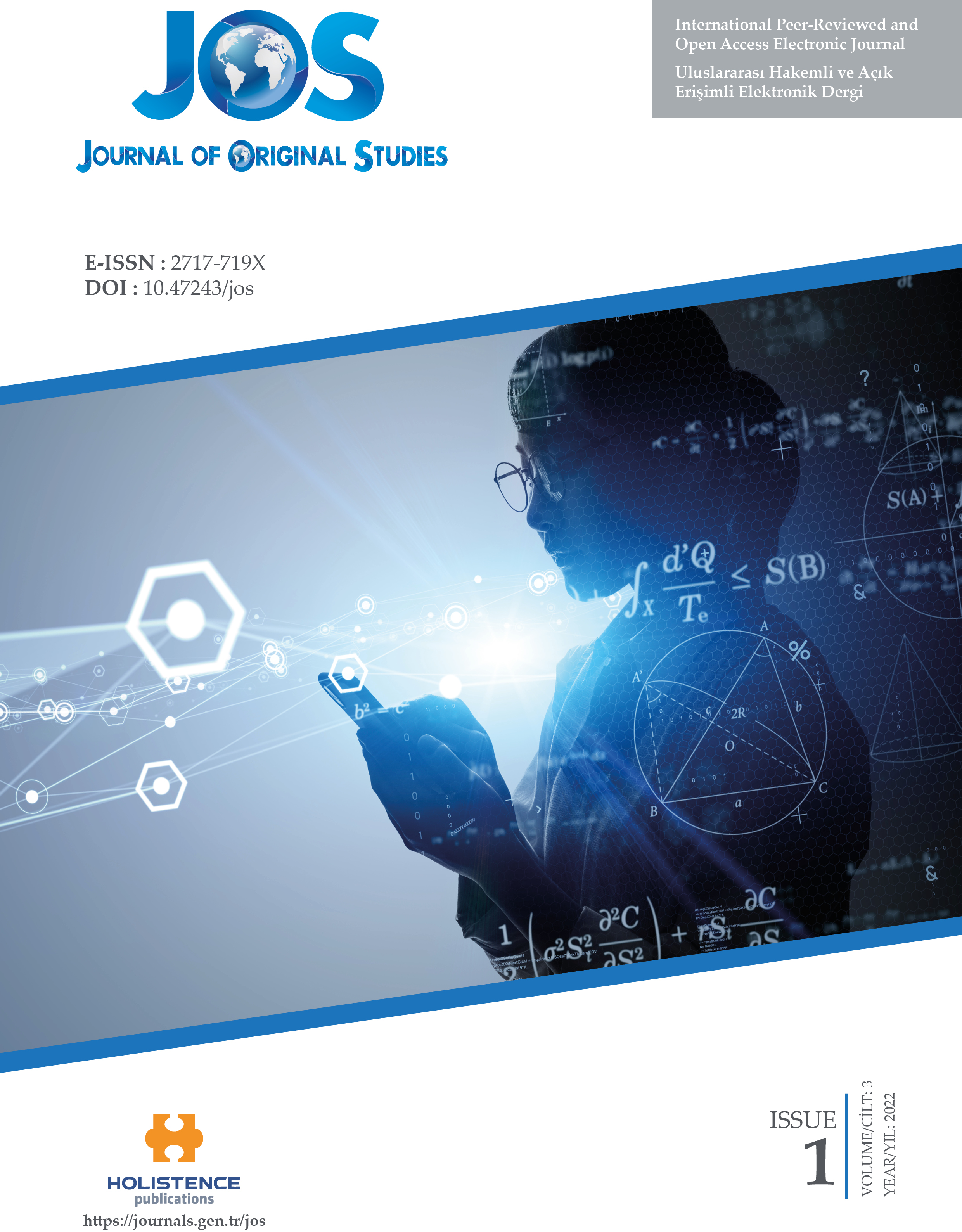Belediye meclislerinde nicel varlıktan nitel varlığa: İhtisas komisyonlarında kadın üyeler
DOI:
https://doi.org/10.47243/jos.3.1.01Anahtar Kelimeler:
Belediye Meclisi- İhtisas Komisyonları- Kadın- Toplumsal Cinsiyet Eşitliği- İstatistiki Bölge Birimleri SınıflandırmasıÖzet
Kentsel yönetimin en önemli aktörü olan belediyelerin temel karar organı, belediye meclisleridir. Belediye meclislerindeki kadın üye oranı, kadınların yerel siyasi kararların alınmasındaki rolü açısından önem taşımakta ve toplumsal cinsiyet eşitliğinin bir göstergesi olarak kabul edilmektedir. Bu gösterge, Birleşmiş Milletler tarafından da özel olarak ele alınmış ve 2015 yılında belirlenen “Sürdürülebilir Kalkınma Amaçları” arasında “Toplumsal Cinsiyet Eşitliği” amacına yer verilmiş, yerel meclislerdeki kadınların sandalye oranı, bu amacın alt hedefleri arasında yer almıştır. Yerel meclislerdeki kadın üye oranı, yerel kararların alınmasında kadınların katkı düzeyini tespit etmek açısından önemli bir gösterge olmakla birlikte, bu katkının niteliğini açıklamamaktadır. Belediye meclislerinde görüşülerek karara bağlanacak olan konular, öncelikle ilgisine göre ihtisas komisyonlarında görüşülerek meclis gündemine alınmaktadır. İhtisas komisyonları, kendilerine havale edilen konularda görüşmeler yaparak meclise rapor sunmakta, bu bakımdan meclis gündemi ve meclis kararları üzerinde bir etkiye sahip olmaktadır. Dolayısıyla yerel kararların alınmasında kadınların rolü değerlendirilirken, yalnızca meclislerdeki sandalye sayısı değil, komisyonlara katılım düzeyleri de incelenmelidir. Bu bağlamda çalışma, belediye meclisleri bünyesinde oluşturulan ihtisas komisyonlarındaki kadın üyelerin sayısını ve oranını konu edinmektedir. Çalışma kapsamında, İstatistiki Bölge Birimleri Düzey 2’de yer alan il ve büyükşehir belediye meclislerinde, kurulması kanunen zorunlu olan ihtisas komisyonlarında yer alan kadın üyelerin sayısı ve oranı tespit edilecektir. Çalışma sonucunda, kadınların yerel kararlara katılım oranının yanı sıra, bu katılımlarının niteliğinin de ortaya konulması amaçlanmaktadır.
İndirmeler
Referanslar
AKSU, H. & KURTULUŞ, H. (2011). “Yerel Temsil ve Katılım Açısından Sivas Belediye Meclisi”, Türk İdare Dergisi, Sayı: 470, ss. 113-132.
ARIKBOĞA, E. (2019). “Belediye Meclislerinde Kadın Üyeler: 2014 Yerel Seçimlerinde Yükselişin ve Değişimin İzini Sürmek”, Aksaray Ü. İİBF Dergisi 11(1), ss. 21-34.
AZAKLI, S. & ÖZGÜR, H. (2005). “Belediye Organları ve Organlar Arası İlişkiler: Başkan, Meclis ve Encümen”, Yerel Yönetimler Üzerine Güncel Yazılar -I: Reform, Editörler: Hüseyin Özgür ve Muhammet Kösecik, ss. 297-319.
ÇELIK, A. & ULUÇ, A. V. (2009). “Yerel Siyasette Temsil Üzerine Bir Çalışma: Şanlıurfa Örneği”, İ.Ü. Siyasal Bilgiler Fakültesi Dergisi, Sayı:41, ss.215-231.
BULUT, Y. & TANIYICI, Ş. (2008). “Türkiye’de Belediye Meclis Üyelerinin Temsil Ediciliği: Erzincan Örneği”, Dumlupınar Üniversitesi Sosyal Bilimler Dergisi, Sayı:21, ss.171-194.
https://ailevecalisma.gov.tr/media/6314/toplumsal-cinsiyet-e%C5%9Fitli%C4%9Fi-ulusal-eylem-plan%C4%B1-2008-2013.pdf, (11.12.2020).
https://www.ailevecalisma.gov.tr/ksgm/ulusal-eylem-planlari/kadinin-guclenmesi-strateji-belgesi-ve-eylem-plani-2018-2023/, (11.12.2020).
https://www.ccre.org/img/uploads/piecesjointe/filename/charte_egalite_tr.pdf, (11.12.2020).
https://www.tbmm.gov.tr/komisyon/kefe/belge/uluslararasi_belgeler/ayrimcilik/CEDAW/CEDAW_Sozlesmesi_ve_Ihtiyari_Protokolu.pdf, (11.12.2020).
https://www.tr.undp.org/content/turkey/tr/home/gender-equality.html, (11.12.2020).
https://www.ysk.gov.tr/tr/haber/mahalli-i%CC%-87dareler-genel-secimleri--kesin-secim-sonuclari/78052, (11.12.2020).
KAŞIKIRIK, A., DOKUZCAN, H., AKPINAR,İ.E. & KARAOĞLU, N. (2020). 2019 Yerel Seçimlerine Toplumsal Cinsiyet Eşitliği Perspektifinden Bakmak. Kader Yayınları, İstanbul.
KÖKEN, E. (2016). “Büyükşehir Belediye Meclisi”, Ankara Üni. Hukuk Fak. Dergisi, 65 (4), ss. 3511-3528.
OKTAY, TARKAN (2013). Yerel Siyaset Bağlamında Belediye Meclis Komisyonları: Marmara Bölgesi Örneği. T.C. Marmara Belediyeler Birliği Yayını: 2013.
ŞAKACI, B. K. (2009). “Yerel Yönetim Seçim Sistemi ve Öneriler Yöntemi”, (Ed.) K. Görmez, M. Ökmen, Yerel Yönetimlerin Güncel Sorunları: Küresel, Bölgesel ve Yerel Perspektifler, Beta, İstanbul.
TÜRELI, N. & ÇAĞLAR N. (2010). “Yerel Yönetimde Kadın Temsili - Isparta İli Örneği”, SDÜ Vizyoner Dergisi, C.2(1) s.16-40.
ULUSOY, A. & AKDEMIR, T. (2010). Mahalli İdareler: Teori-Uygulama-Maliye, Seçkin Yayıncılık, Ankara.
YILDIRIM, U., ÖNER, Ş., AKSU, H. VE TATLI, S. M. (2011). “Yerel Temsil ve Katılım Bağlamında Belediye Meclisleri: Kahramanmaraş ve Sivas Örnekleri”, Mustafa Kemal Üniversitesi Sosyal Bilimler Enstitüsü Dergisi, Cilt: 8(15) ss. 507 – 530.
Sayılı “Büyükşehir Belediye Kanunu, https://www.mevzuat.gov.tr/MevzuatMetin/1.5.5216.pdf, (03.12.2020).
Sayılı Belediye Kanunu, https://www.mevzuat. gov.tr/MevzuatMetin/1.5.5393.pdf, (03.12.2020).
İndir
Yayınlanmış
Nasıl Atıf Yapılır
Sayı
Bölüm
Lisans
Telif Hakkı (c) 2022 Holistence Publications

Bu çalışma Creative Commons Attribution 4.0 International License ile lisanslanmıştır.
Yazarlar, makale Journal of Orijinal Studies'te yayınlanmak üzere kabul edildiğinde .makalenin içeriğindeki tüm telif haklarını, Rating Academy Ar-Ge Yazılım Yayıncılık Eğitim Danışmanlık ve Organizasyon Ticaret Ltd. Şti’ne devrederler. Yazarlar, patent hakları gibi telif hakkı dışındaki tüm mülkiyet haklarını saklı tutar.
Bu makalede yazar olarak listelenen herkes çalışmaya önemli, doğrudan, entelektüel katkılar yapmış olmalı ve bunun için kamu sorumluluğu almalıdır.
Bu makale daha once yayınlanmamış ve başka dergilerde yayınlanmak üzere gönderilmemiştir.









